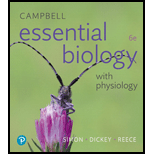
Concept explainers
To explain: Under which condition the rotifers and aphids are able to reproduce asexually.
Concept introduction: Living beings use two types of reproduction to produce offspring, one is asexual reproduction and the other is sexual reproduction. In asexual reproduction, only one organism is involved, and the offspring produced are genetically alike. Asexual reproduction occurs in many plants, for example spider plants, bacteria, hydra, yeast, and jellyfish. Sexual reproduction involves the fusion of male and female gametes. In this type of reproduction, two parents contribute genetic information to produce unique offspring. It occurs in most mammals, fish, reptiles, birds, and insects.
Explanation of Solution
Rotifers and aphids reproduce both by sexually and asexually or parthenogenetically. For asexual reproduction, stable environmental conditions are most favorable conditions. Under asexual reproduction, various processes like budding and binary fission take place. In this process, genetically identical offspring are produced. These genetically identical individuals prefer to live in a same stable environment that provides the offspring a better chance to survive.
To explain: Under which condition the rotifers and aphids are able to reproduce sexually.
Concept introduction: Living beings use two types of reproduction to produce offspring, one is asexual reproduction and the other is sexual reproduction. In asexual reproduction, only one organism is involved, and the offspring produced are genetically alike. Asexual reproduction occurs in many plants, for example spider plants, bacteria, hydra, yeast, and jellyfish. Sexual reproduction involves the fusion of male and female gametes. In this type of reproduction, two parents contribute genetic information to produce unique offspring. It occurs in most mammals, fish, reptiles, birds, and insects.
Explanation of Solution
Rotifers and aphids reproduce both by sexual reproduction and parthenogenesis. The continuous changing environmental conditions are more favorable for sexual reproduction. In autumn, aphids reproduce by sexual process and lay eggs. A change in photoperiod, temperature, and food quality and quantity causes female to reproduce parthenogenetically. Sexual reproduction takes place between males and females, which give rise to genetically different offspring. This changing environment is more suitable to reproduce genetically different offspring.
Want to see more full solutions like this?
Chapter 26 Solutions
Campbell Essential Biology with Physiology (6th Edition)
- What is a likely evolutionary advantage of sexual reproduction over asexual reproduction? a. sexual reproduction involves fewer steps b. less chance of using up the resources in a given environment c. sexual reproduction results in greater variation in the offspring d. sexual reproduction is more cost-effectivearrow_forwardWhich of the following is an advantage of asexual reproduction over sexual reproduction?arrow_forwardwhich asexual and sexual reproduction animals will most likely survive after a virus/bacterial outbreak? Why?arrow_forward
- What advantages does asexual reproduction have over sexual reproduction?arrow_forwardSome animals like Aphids, sea anemones, starfishes, sea stars can reproduceasexually and sexually. What will be the advantage and disadvantage ofproducing through asexual and asexual method?arrow_forwardWhy do we still see organisms reproduce asexually? In what situations and organisms would we expect to see asexual reproduction occur?arrow_forward
- Which of the following is an advantage of asexual reproduction over sexual reproduction? A. Asexual reproduction leads to offspring with high genetic diversity. B. Asexual reproduction requires a partner. C. The resulting offspring have no genetic diversity. D. Asexual reproduction does not require a partner.arrow_forwardWhat is the scientific purpose of having two genders in all living beings when reproduction could be reached asexually?arrow_forwardWhy does sexual reproduction persist even though it requires moreenergy than asexual reproduction?arrow_forward
 Concepts of BiologyBiologyISBN:9781938168116Author:Samantha Fowler, Rebecca Roush, James WisePublisher:OpenStax College
Concepts of BiologyBiologyISBN:9781938168116Author:Samantha Fowler, Rebecca Roush, James WisePublisher:OpenStax College
